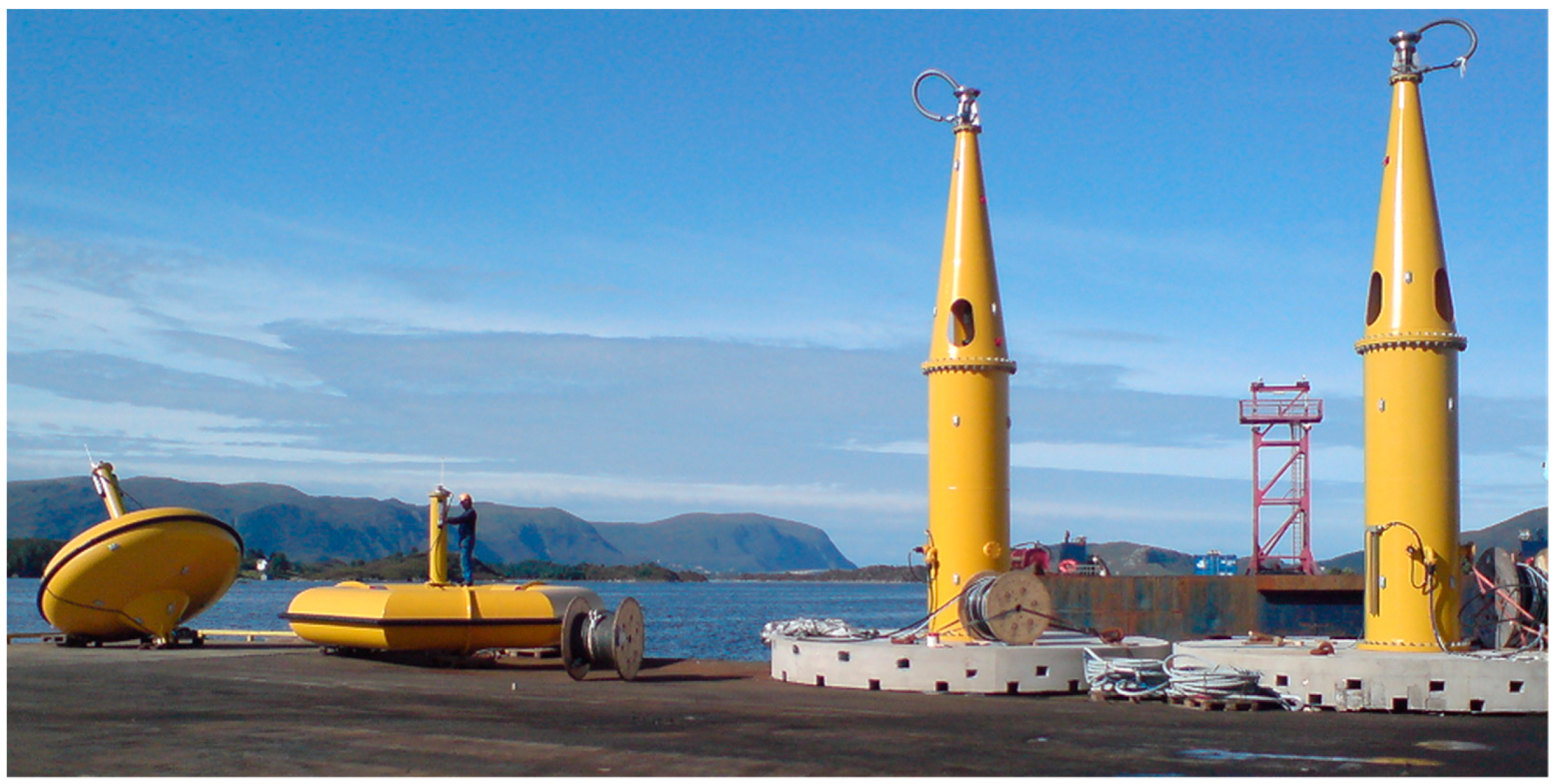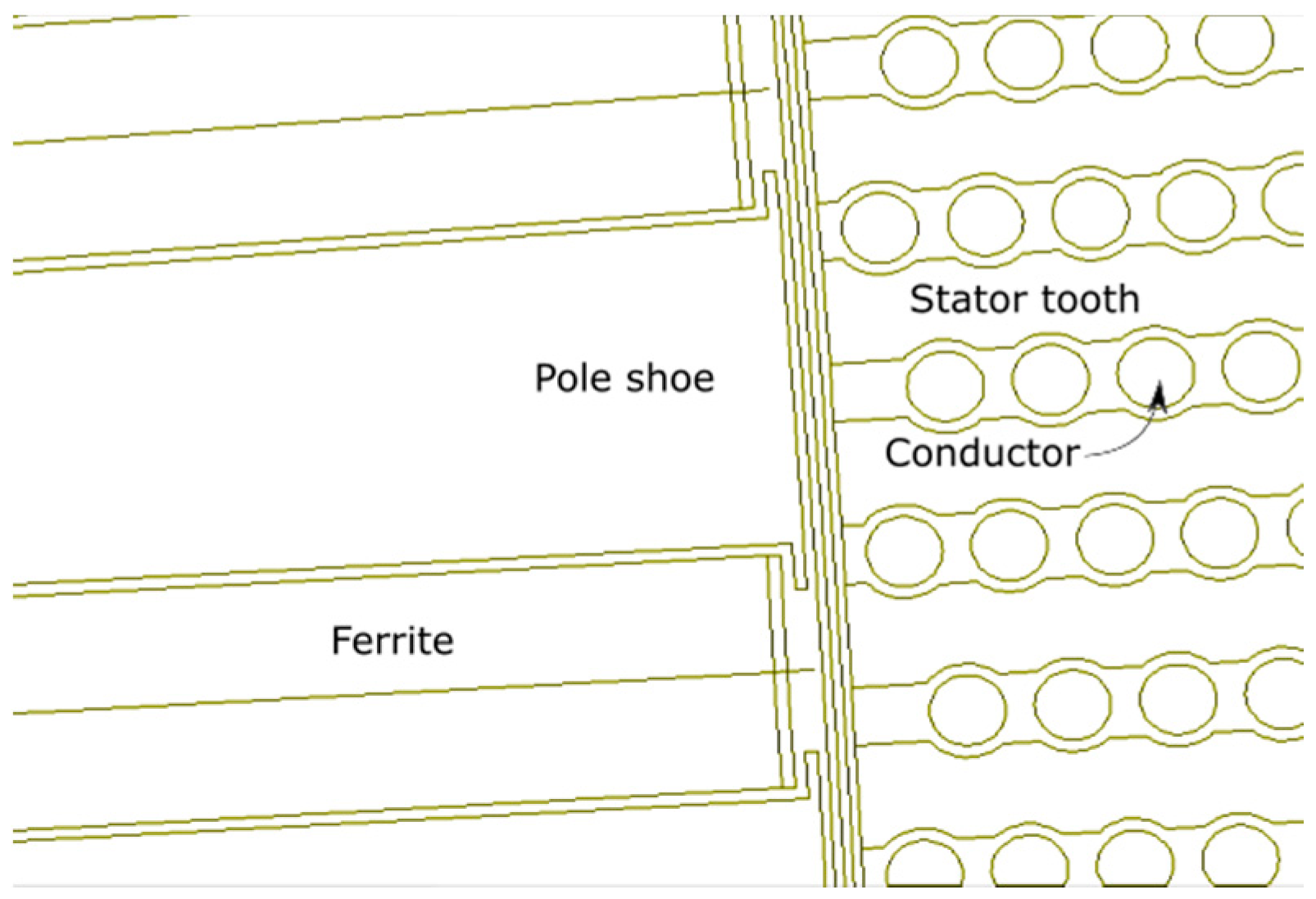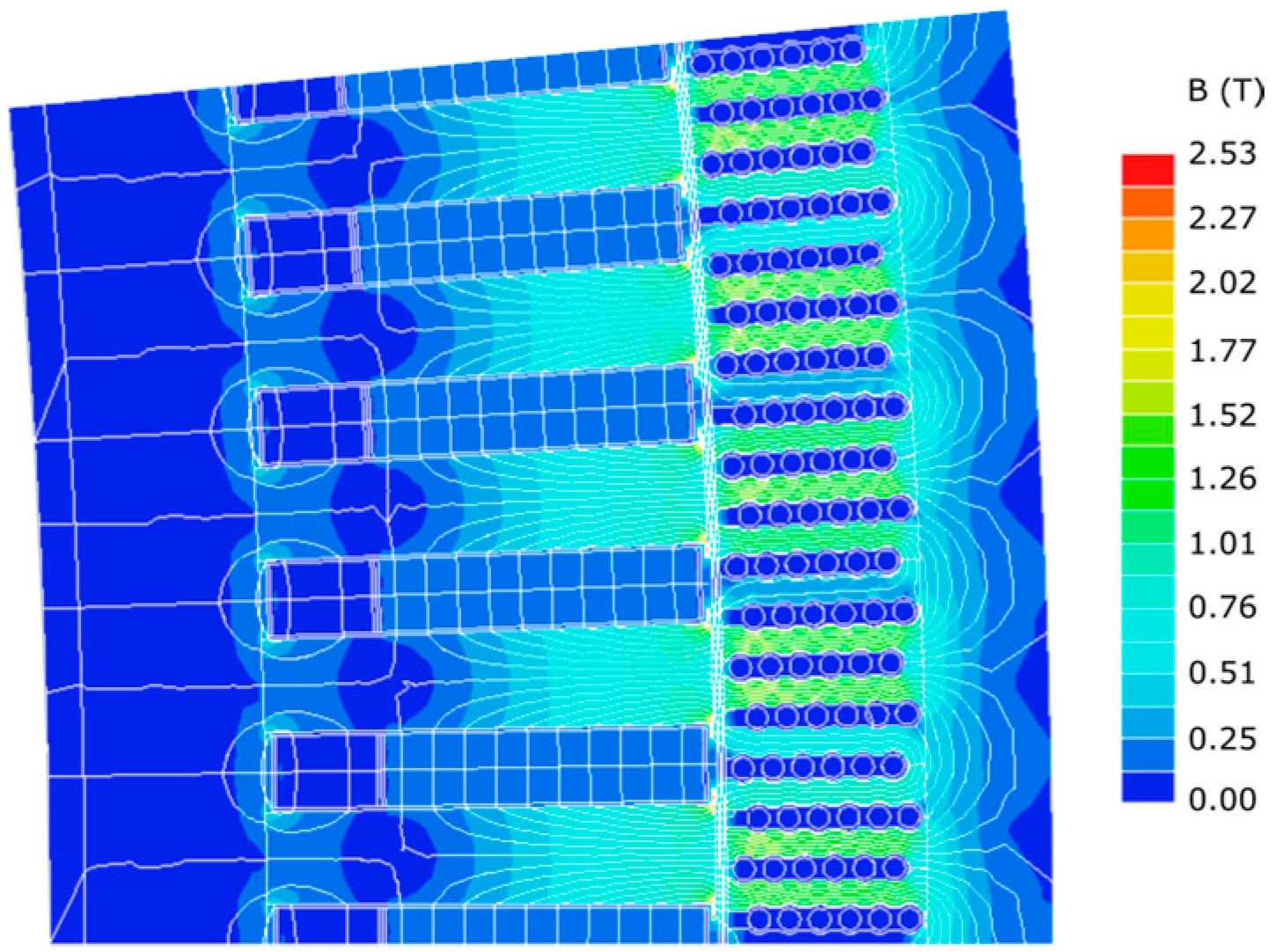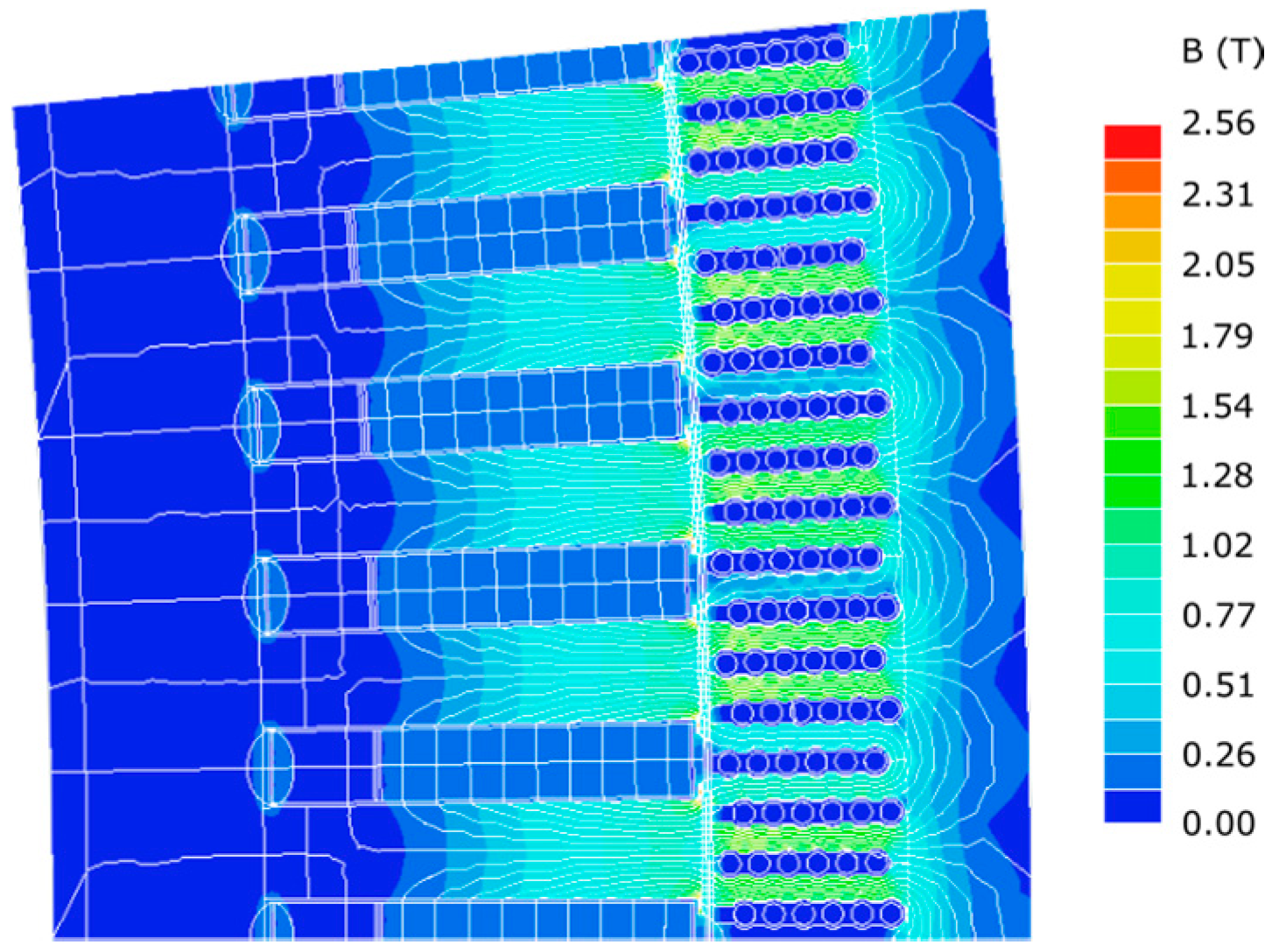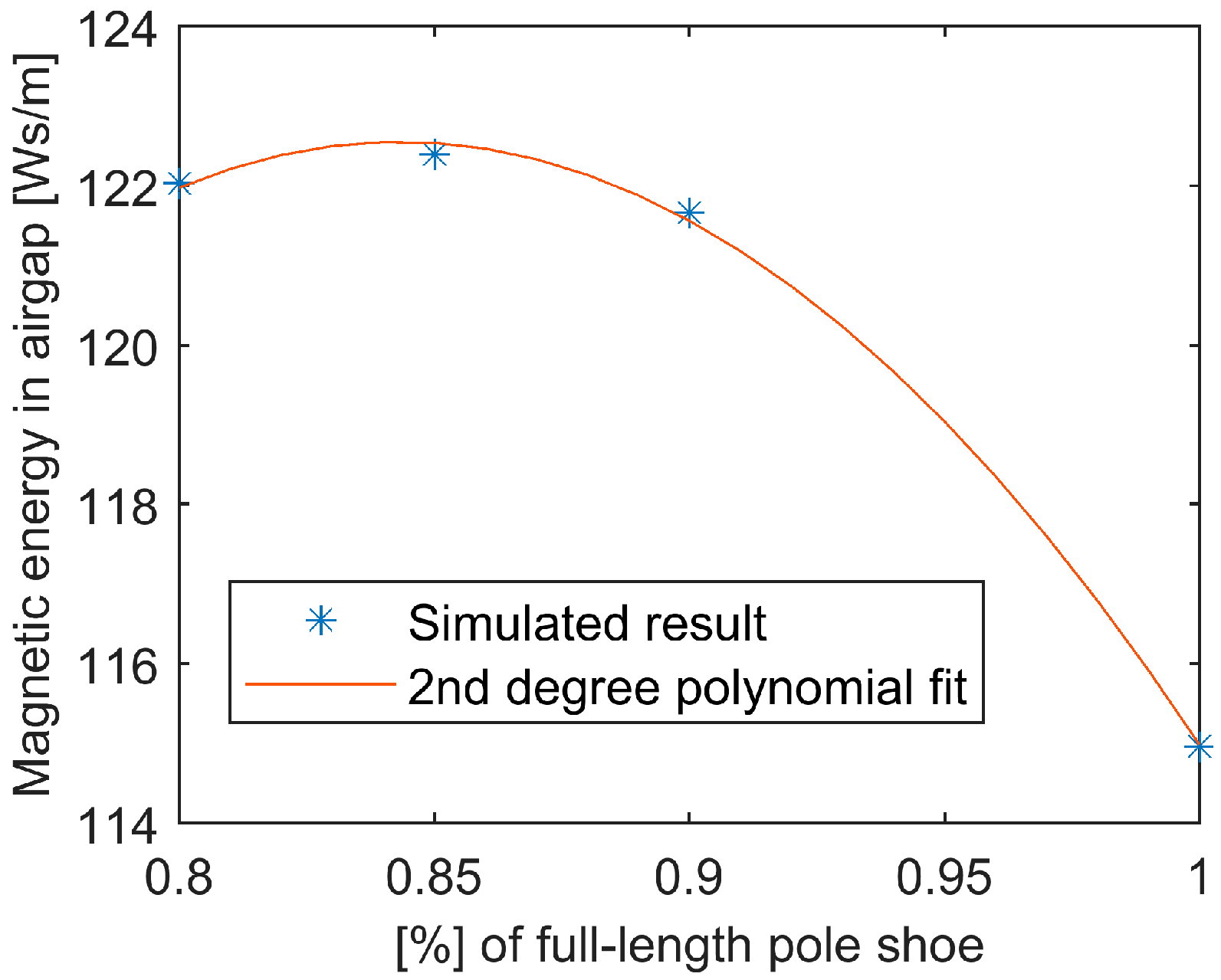1. Introduction
Energy contained in ocean waves is considered a promising source of renewable energy by many countries. Although the first patent on the wave energy conversion technique was obtained more than 100 years ago [
1], different research groups all over the world are still striving to develop an efficient and economically viable means of converting wave energy to electrical energy [
2]. A diverse variety of wave energy converters (WECs) can be classified based on their location, type of absorption, and power take-off [
1,
3,
4].
The WEC concept developed at Uppsala University in Sweden, illustrated in
Figure 1a, is an offshore device of a point absorption type with a permanent magnet linear generator (PMLG) power take-off. The PMLG is directly driven and placed on the seabed, and protected from seawater by a watertight hull. The linear generator (LG) contains a stator and a translator with magnets [
5], as shown in
Figure 1b. A voltage is induced in the stator coils due to the relative translator motion. The operational principle is rather simple, ensuring the WEC’s robustness, low cost, and sustainability. Seabased Industry AB (Lysekil, Sweden,
http://www.seabased.com/en/) is currently commercializing a similar WEC with previous projects in Scandinavia and Ghana [
6].
Figure 2 shows a photo of buoys and translators on the harbor before offshore deployment in Norway.
Since 2006, the WEC system developed at Uppsala University has undergone several offshore experiments at the research site in Lysekil, Sweden [
7,
8,
9,
10,
11], covering different aspects on wave energy conversion including the environmental aspects [
12,
13], wave power park layout analysis [
14], manufacturing [
15,
16] and deployment [
6] processes, WEC survivability in extreme seas [
17], and efficiency of WECs subjected to tides [
18].
An application of a direct drive PMLG for wave energy conversion (mainly used for the Archimedes Wave Swings) was suggested in [
19]. PMLGs for single-body point absorbers were discussed in [
20,
21] and for two-body floating point absorbers in [
22]. Various topologies for PMLG for wave power conversion were summarized in [
23], and some generator designs were compared in [
23,
24,
25,
26]. The type of magnets in the LG affects the performance and sustainability of the WEC. A sketch of the magnetic field of the Uppsala WEC is shown in
Figure 3 [
27]. Nd
2Fe
14B-magnets can be used in the LG. Issues regarding environment, health, and price [
28] do however make these rare earth magnets unfit for a sustainable WEC. Ferrite permanent magnets (PMs), with magnetization in the direction of motion, are placed between pole shoes and used in the LG. This setup is proving to be a sustainable alternative to Nd
2Fe
14B [
27,
29].
The aim of this paper is to discuss an altered magnetic circuit of a PMLG for wave energy conversion. The magnetic energy in the airgap between the stator and translator is determined, using the finite element method (FEM) simulations, as parts of the magnetic material and the pole shoes are altered from the previous design, where only one type of ferrite and rectangular pole shoes was included. There are several reasons as to why it would be interesting to further study different magnetic circuit designs of the LG: the stronger Y40 magnets [
30] are generally more expensive than Y30 and are not available from all manufacturers; increasing the flexibility of the magnetic circuit may open up the possibility of using cheaper PMs, shorter material transportations, in-house magnet production and so on; and the different designs of pole shoes can decrease magnetic leakage flux in the LG, resulting in a higher magnetic energy in its airgap, possibly increasing the performance of the LG. The following study was previously included as a conference [
31] and the manuscript has been revised and partly rewritten with additional discussions, for example, on magnet costs.
Previous studies have suggested that a mixed magnet grade design can be used for electrical machines [
32,
33,
34,
35,
36,
37,
38,
39]. Several of these studies have discussed magnetic circuits with rare earth magnets [
34,
35,
36,
38,
39], whereas others included ferrites [
32,
33] or a mixture of ferrites and rare earth metals [
37]. Most reviewed research on mixed magnet grade involved rotating machines [
32,
33,
34,
35,
37,
38,
39]; however, a linear PM motor was studied in [
36]. The focus of these publications were generally of the torque- or total harmonic distortion (THD) measurements of the system [
36,
37,
38,
39] or its demagnetization behavior [
32,
33,
34,
35]. A number of studies have investigated linear machines with magnetization in the direction of motion [
40,
41,
42,
43,
44]. Furthermore, modified pole shoes for a rotating PM synchronous wind turbine [
45] and different salient pole shoe faces for a synchronous machine [
46] were previously studied. However, none of the reviewed literature has looked into the influence of replacing a fraction of the pole shoe with a non-magnetic material closest to the shaft or using mixed magnet grading for the studied WEC system.
2. Theory and Method
The theoretical background of this study is based on Maxwell’s equations. The PMs (here divided magnets) are modelled by a current sheet approach, as described in [
47]. A magnetic vector potential,
A, is used in Maxwell’s equations and the contribution from displacement currents is neglected. As described in [
48], the time-dependent induced eddy currents are removed for a steady state simulation, resulting in:
where the source current density
represents the current densities of the stator windings and
represents the permanent magnets as an equivalent current density [
49].
In this study, an in-house developed program Ace (developed at ABB AB, Coporate Research, Västerås, Sweden) was used to model the magnetic circuit of the LG [
50]. The software solves Maxwell’s equations for a two-dimensional segment of a generator using FEM, approximating a constant field in the axis of the conductor windings and simulating each magnet as a closed current loop. Several previous studies have used this simulation tool and the results were verified with experimental data in [
51,
52]. Simulations in Ace on a segment of the LG were previously presented in [
53,
54] and the longitudinal end effects of the LG were studied more thoroughly in [
55]. These effects are neglected here. A segment of the studied WEC LG is shown in
Figure 4, illustrating the translator, with ferrite PMs and T-shaped pole shoes, next to the stator, with coils and stator steel. This geometry is used in Ace.
The properties of magnets used in the modelling are inserted into the software. Here, the ferrite PMs of type Y30 and Y40 are investigated. In
Table 1, some important properties of Y30 and Y40 are shown [
30]. Y40 is a stronger ferrite PM than Y30. The relative permeability of Y30 and Y40 were calculated using the mean values of the remanence and the energy product. All values are presented in
Table 1.
The cost of ferrites varies with the chosen retailer, the size and geometry of the magnet, the number of magnets bought at the same time and so on, according to contacted retailers with delivery to Sweden (Bakker Magnetics, (Eindhoven, The Netherlands)
www.bakkermagnetics.com/en; Compotech, (Stockholm, Sweden)
www.en.compotech.se/; BJA Magnetics (Leominster, MA, USA)
www.bjamagnetics.com/). It is indicated that the price of Y40 is several times higher than Y30 for this large size. In the following analysis, we have used the ratio 6:1 when comparing the prices of Y40 to Y30. The cost of Y40 is higher than Y30 because of the increased magnetic properties and the more advanced manufacturing processes involved when producing larger magnets of higher grading. The relative cost difference between Y30 and Y40 increases with magnet size. The prices of the magnets generally increase with the strength of the magnets. Moreover, the delivery (shipping) time, capacity and the cost of other necessary tools for processing may affect the overall price and choice of suitable retailer.
The method of this study is to perform simulations in Ace for a section of the LG with a stepwise altered magnetic circuit, partly changing the ferrites from Y40 to Y30, while altering the shape of the pole shoes to increase the magnetic energy in the airgap. The study is restricted to include only two types of ferrites (Y30 and Y40) and two types of pole shoes (rectangular and T-shaped). The simulations in Ace are subdivided into three studies, as described in more detail, namely investigations of mixed ferrite permanent magnets, different designs of pole shoes and the combination of mixed magnets and different pole shoes. The results from all studies are analyzed and some conclusions are drawn.
2.1. Mixed Ferrite Permanent Magnets
The magnetic material in the LG is changed from 100% of Y40 to 100% of Y30 in several steps, where some cases include both Y40 and Y30, as described in
Table 2. The total length of the magnetic material is 120 mm and the width is 20 mm. The pole shoes are rectangular with a length of 124 mm and width 15 mm.
2.2. Different Designs of Pole Shoes
The second study is restricted to two different shapes of pole shoes, namely rectangular and T-shaped, as described in
Table 3 and shown in
Figure 4. The magnets are of type Y40. The T-shaped pole, with more material in the proximity of the stator, may increase the portion of magnetic flux through the airgap and stator.
2.3. Mixed Magnets and Different Pole Shoes
Some combinations of the Y30 and Y40 magnets are investigated together with T-shaped pole shoes of different length, as described in
Table 4.
4. Discussion
Offshore marine renewable energy, such as wave power and marine current power, has slowly become more cost-efficient and reliable. Marine renewable energy has been considered an alternative energy source for countries with a coastline, possibly challenging the more established renewable energy sources, such as solar or wind power. Moreover, several parts of the world realize the possibility of powering small communities or certain services (such as desalination plants [
56]) with renewable energy. Increasing the number of intermittent energy sources naturally imposes many engineering challenges and in order to improve the wave energy systems, which is discussed in this paper, careful consideration of the entire process from wave-to-wire should be undertaken. In this light, the LG of the WEC designed in Sweden continues to benefit from research concerning the (economic, environmental, and social) sustainability of the system. This research approaches the sustainability of one of its features, namely the sustainability of the LG, and specifically its magnetic circuit.
There is a price difference between the stronger and more expensive Y40 and the less strong magnet Y30, as noted in
Section 2. The prices of ferrites are today strongly dependent on magnet sizes, grades and purchased quantities. The price of regular (large) sized ferrites, suitable for this type of WEC, with certified quality Y40 is about six times more expensive than an Y30 of same size, geometry and quantity, according to current retailers. Meanwhile, much smaller ferrite magnets of type Y40 are seemingly more in the same price range as Y30 magnets (where Y30 is about 30% cheaper according to retailers). The relative price difference between magnets of type Y30 and Y40 will go from 1:6, for large magnets, towards more similar values for smaller sizes. However, all results still indicate that it is more affordable with Y30 magnets than Y40 and that Y40 should be put closest to the airgap, if both Y30 and Y40 are included in the magnetic circuit. As the magnet prices are size dependent, it may be interesting to change one large magnet into several smaller magnets, if the generator design enables their mounting. The more advanced instruments needed for producing larger magnets of higher grading influences the costs, and not all manufacturers provide ferrites of Y40 quality. That is, the overall supply and demand affects the ferrite prices. This further suggests that it is interesting to look into the possibility of varying the magnetic circuit of a PM generator, or varying the shapes and sizes of the magnets to optimize the overall price and to ensure a reliable magnet cost. From an industrial point of view, the development of a flexible magnetic circuit (possibly produced with different types of magnets and pole shoes) can reduce the overall WEC cost in several ways, for example, by increasing the power output of the WEC, and taking the opportunity to more freely choose which company to produce the magnets and the requirements of the magnets in terms of quantity, quality, geometry, transportation, ethical working situation and so on. Moreover, it may be possible to produce some magnets in-house. In the future, an LG with mixed types of ferrite permanent magnets might be constructed and studied experimentally.
The power output from a WEC LG generally increases with increasing magnetic energy in the stator/translator airgap (unless the stator steel gets saturated or the WEC is undersized in some way). However, how much the variations of magnetic energy in the airgap affect the voltage induced in the WEC coil windings and the power output of the WEC have not been fully studied here. That is, there are still questions on whether this type of (more complicated) circuit design is justifiable from the cost perspective. Moreover, the dimensions of the suggested T-shaped pole shoes, described in
Table 3, are so small that the suggested pole shoe design may only be possible and interesting to study in simulations at this stage.
When altering the magnetic circuit of an LG to obtain a higher sustainability, a similar or increased magnetic performance compared to other circuit designs is desirable. Comparing the resulting values for an LG with rectangular pole shoes and only Y40 magnets, as presented in
Table 5, Case 1 (123 Ws/m), with the values for a mixed Y30 and Y40 LG with T-shaped pole shoes (see
Table 7), the performance in terms of magnetic energy in the stator/translator airgap was similar although the magnetic circuit was redesigned.
As can be seen in
Figure 6, there is an approximately linear relation between the magnetic energy per unit stack length in the airgap and the amount of Y40 in the linear generator. As the stronger magnetic material (Y40) is placed further away from the stator steel, the leakage flux, which does not reach the airgap, increases, resulting in a lower magnetic energy in the airgap than for those cases where the stronger magnetic material is placed closer to the stator.
Figure 6 also indicates that the current sheet approach for modelling the magnets may cause small additional magnetic flux paths for the divided magnets, when simulating this system. Naturally, all resulting figures and values presented in the results are limited in accuracy and resolution by the features of the simulation tool.
The current study found that it is possible to increase the magnetic energy in the airgap by altering the design of the pole shoes: making them shorter and changing their shapes from a rectangular shape to a T-shape. The shape is changed in order to decrease the leakage flux in the LG. By examining
Figure 5, a magnetic flux leakage from the left part of the magnet, not reaching the stator, can be identified. In order to increase the magnetic energy in the airgap between the stator and translator, a shorter pole shoe was a successful choice, redirecting the previous magnetic leakage flux towards the stator. A T-shaped pole shoe also increased the magnetic energy in the airgap slightly compared to a regular rectangular pole shoe. However, due to the more advanced geometry of the pole shoe, the change in shape from a rectangular to a T-shaped pole shoe may not be the best choice from an industrial point of view. The shorter pole shoes (of a rectangular shape) are seemingly easier to manufacture than the full-length T-shaped pole shoe.
5. Conclusions
In this paper, the magnetic circuit of an LG, for a direct-driven wave power system, was studied using FEM simulations with the software Ace. The results provided estimations of the magnetic energy in the airgap between the stator and translator (Ws/m), as the magnetic properties of the LG were changed in different design steps. The study presents an alternative design of an LG with different ferrite PMs (of the type Y30 and Y40) and pole shoes (rectangular and T-shaped). Changing parts of the magnetic material from Y40 to Y30 leads to a decrease in the resulting airgap magnetic energy. On the other hand, the magnetic energy in the airgap increased as the ferrite of type Y40 was placed closer to the stator steel than Y30 (for mixed magnets), as this lowers the magnetic leakage flux in the circuit. The cost of the ferrites with high grading (i.e., Y40) is increasing with block size, due to a more advanced manufacturing process for larger magnets of high grading. The possibility to reduce costs with the use of smaller magnets is a strong argument to why this kind of investigation for magnetic circuits of electrical machines for industrial purposes can be interesting to continue with in the future.
It can be concluded that a shortened pole shoe increases the magnetic energy in the airgap, since it decreases the leakage flux and thereby redirects the flux towards the airgap. For the studied case, the optimal pole shoe length was found to be 85% of its original length. This study has identified that the pole shoe design will change the features of the LG magnetic circuit. In industry, there will be a trade-off between ferrite and pole shoe costs. More research is needed in order to establish if it will be interesting, from a sustainability perspective, to create an LG using mixed types of ferrites and pole shoe designs.

